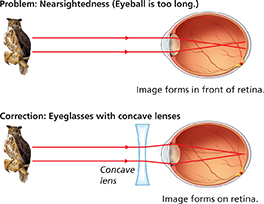Rods and Cones
Low-intensity light is sensed by rods. The brain uses signals from rods to distinguish among white, black, and different shades of gray. Cones are sensitive to color, but are less sensitive than rods; that is, they need more light than rods in order to function. The decreased light sensitivity of cones explains why you can't make out the colors of objects in very dim light. There are three different types of cones. Each type of cone is able to sense only a single color— red light, green light, or blue light. People who are colorblind have missing or defective cones of one or more of the three kinds.
Correcting Vision Problems
You have probably heard the expression “20/20 vision.” Having 20/20 vision means that you can clearly see things of a certain size from 20 feet. 20/20 vision is considered normal. Not everybody, however, has 20/20 vision.  Several common vision problems are nearsightedness, farsightedness, and astigmatism. They result in people having vision that is worse than 20/20. In many cases, less-than-perfect vision can be corrected with eyeglasses or contact lenses. Corrective eyeware is not new—eyeglasses were used in China and Italy as early as the 1200s.
Several common vision problems are nearsightedness, farsightedness, and astigmatism. They result in people having vision that is worse than 20/20. In many cases, less-than-perfect vision can be corrected with eyeglasses or contact lenses. Corrective eyeware is not new—eyeglasses were used in China and Italy as early as the 1200s.
Nearsightedness
If you have normal vision, the images you see are clear and undistorted. The light rays that enter your eyes are focused on your retinas. However, for approximately one out of four people, the rays focus before they reach the retina. This condition, called nearsightedness, causes distant objects to appear blurry. Nearsightedness occurs either because the cornea is too curved or the eyeball is too long. In either case, the rays of light focus too close to the lens. A nearsighted person can see nearby objects clearly, but distant objects seem blurred. Nearsightedness can be corrected by placing a diverging (concave) lens in front of the eye. The lens spreads the rays out a little before they enter the eye. This causes the image to form farther back, at the retina, instead of in front of it. Some cases of nearsightedness can now be treated with surgery. Figure 18 shows a diagram of a nearsighted eye and how it can be corrected with a diverging (concave) lens.
Figure 18 When the eyeball is too long, the focused image forms in front of the retina. By the time the image reaches the retina, it is no longer in focus. This common condition, called nearsightedness, can be corrected with a diverging (concave) lens.
 d
d




